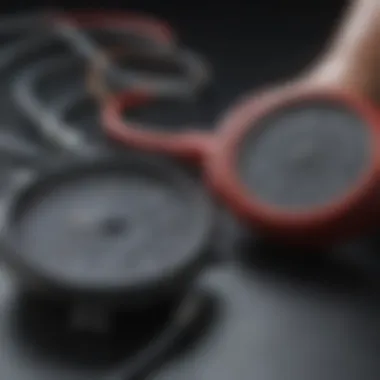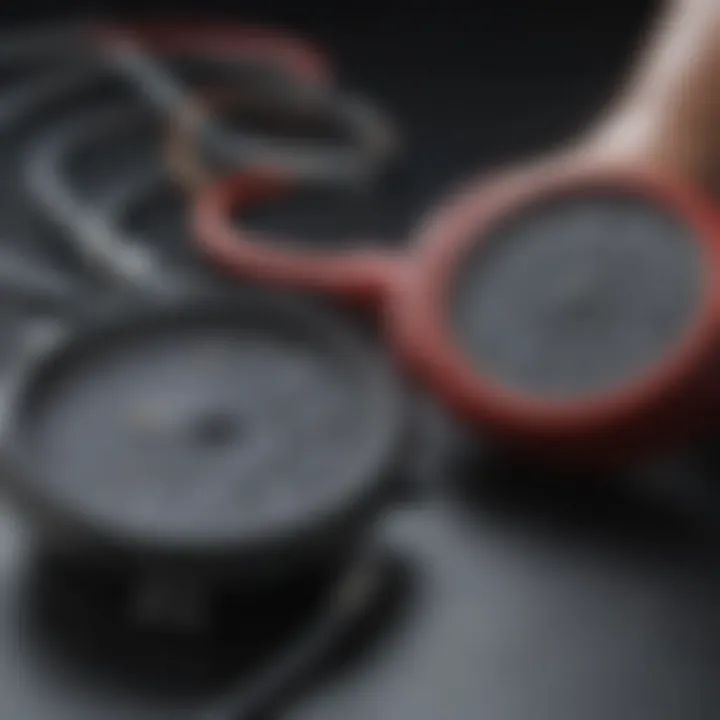Innovative Rings: A New Era for Blood Pressure Monitoring


Overview of Research Topic
The integration of wearable technology into healthcare has opened up new avenues for personal health management. This article focuses on the specific application of rings for blood pressure monitoring, an area that holds significant promise in improving health outcomes. Unlike traditional blood pressure cuffs, rings offer a less intrusive and more user-friendly method for continuous monitoring. As health becomes increasingly quantified, the demand for effective, accurate, and comfortable devices increases.
Brief Background and Context
Historically, blood pressure measurement has relied on manual and semi-automated devices that typically require user intervention. With the advent of wearable technology, we have seen a shift towards automated and continuous monitoring systems that promise convenience and real-time data collection. This transition is not just a matter of technological advancement; it reflects a broader change in how we approach health monitoring. Rings designed for this purpose represent a unique intersection of innovation, convenience, and accessibility.
Importance in Current Scientific Landscape
The significance of wearable technology in health cannot be overstated. According to recent studies, hypertension affects millions globally and can lead to severe health issues if not managed properly. Devices that allow for consistent monitoring can mitigate risks associated with delayed diagnoses or improper health tracking. The development of a ring that can accurately track blood pressure may be pivotal in preventive healthcare, offering an innovative solution that elevates our ability to manage personal health effectively
Methodology
Research Design and Approach
This examination of blood pressure monitoring rings involves a multifaceted approach. The design categories include technological evaluations, user experience assessments, and performance comparisons between wearable rings and traditional blood pressure monitoring devices.
Data Collection Techniques
Data for this analysis is collected from various methods, including but not limited to:
- Clinical Trials: Analyzing the effectiveness of specific products in real-world settings.
- User Surveys: Gathering feedback on usability and satisfaction from users of these devices.
- Literature Reviews: Synthesizing existing research findings regarding wearable technology in health management.
The combination of these techniques ensures a comprehensive overview of the capabilities and potential of rings tailored for blood pressure monitoring.
“The journey toward smarter health technology is ongoing, and wearable rings are at the forefront of this transformative wave.”
As this article unfolds, it will delve deeper into the mechanisms, accuracy, and future trends surrounding the application of rings in blood pressure monitoring.
Prologue to Blood Pressure Monitoring
Blood pressure monitoring is crucial for understanding cardiovascular health. As one of the vital signs, it helps to assess the overall well-being of individuals. The significance of this monitoring cannot be overstated, given that hypertension is a leading risk factor for various health issues, including heart attack and stroke. Monitoring blood pressure allows for early detection of potential problems, enabling timely intervention and health management.
Definition of Blood Pressure
Blood pressure refers to the force exerted by circulating blood against the walls of blood vessels. It is measured in millimeters of mercury (mmHg) and is expressed using two values: systolic pressure and diastolic pressure. The systolic pressure occurs when the heart beats and pumps blood, while the diastolic pressure is measured when the heart is at rest between beats. This measurement is fundamental to identifying whether an individual has a healthy baseline or is at risk of hypertension.
Importance of Monitoring Blood Pressure
The regular monitoring of blood pressure serves multiple important purposes:
- Detection of Hypertension: Regular checks can reveal if an individual is developing high blood pressure, which often has no symptoms until it is too late.
- Risk Assessment: For patients with existing conditions or family history of heart disease, ongoing monitoring is critical to assess the effectiveness of treatment efforts.
- Informing Treatment Decisions: Blood pressure readings guide healthcare providers in tailoring treatment plans, adjusting medications, or recommending lifestyle changes.
- Promoting Awareness: Increased awareness among individuals about their own blood pressure levels can motivate healthy lifestyle choices and proactive health measures.
Monitoring blood pressure is not just for those already diagnosed. It plays a preventive role, helping maintain good health across populations.
In summary, understanding and monitoring blood pressure is essential for maintaining cardiovascular health. Rings as a wearable technology for blood pressure monitoring represent innovative advancements that can simplify this process. This article will delve into the mechanisms, accuracy, and future potential of such devices in the healthcare landscape.
Conventional Methods for Blood Pressure Measurement
Conventional methods for measuring blood pressure play a vital role in clinical practice and personal health management. These methods, particularly the sphygmomanometer, have been the standard for decades. Understanding these methods is essential for evaluating the innovations in wearable technology, especially rings designed for blood pressure monitoring. It allows for a better integration of new tech with established medical practices, thus improving patient care.
Blood pressure is a crucial health indicator, correlating with cardiovascular diseases. Therefore, accurate measurements are necessary. Conventional devices provide a reference point for validating the reliability of newer technologies. Moreover, this comparison aids in understanding user expectations when integrating devices into their daily routines.
Sphygmomanometer Overview


The sphygmomanometer is the traditional device used to measure blood pressure. It generally consists of an inflatable cuff, a measuring unit, and a stethoscope, or an automatic digital readout. The procedure involves wrapping the cuff around the upper arm and inflating it to a pressure that temporarily stops blood flow. The pressure in the cuff is then slowly released. Two important values are noted:
- Systolic Pressure: This is the pressure in the arteries when the heart beats.
- Diastolic Pressure: This represents the pressure in the arteries when the heart is at rest between beats.
The readings are typically expressed in millimeters of mercury (mmHg). The sphygmomanometer’s simplicity and reliability contribute to its longstanding use in both clinical and home settings. However, understanding its mechanics can illuminate why new technologies, like blood pressure rings, aim to improve upon these methods.
Limitations of Traditional Devices
Despite the effectiveness of the sphygmomanometer, several limitations exist.
- Manual Operation: The traditional sphygmomanometer can require trained personnel for accurate measurements, leading to potential human errors.
- Inconvenience: It may not be practical for daily use due to the time taken to measure and the need for a quiet environment.
- Single Readings: Traditional devices typically provide single, static measurements which can mask fluctuations in blood pressure over time.
Furthermore, the reliance on periodic measurements does not capture the variability of blood pressure throughout the day. This aspect limits the ability to identify patterns or trends that may need medical intervention.
A growing awareness of these drawbacks creates the demand for more user-friendly and continuous monitoring solutions. It sets the stage for wearable devices like rings to offer a more holistic approach to blood pressure management.
"As healthcare technology evolves, understanding the past becomes crucial for embracing the future."
In summary, while conventional methods like the sphygmomanometer are essential for blood pressure assessment, their limitations highlight the necessity for innovation. \nThis sets the context for the exploration of newer devices that can address those weaknesses while promoting regular health monitoring.
Emergence of Wearable Technology in Healthcare
The emergence of wearable technology in healthcare is a significant development, revolutionizing how we monitor various health indicators, including blood pressure. Wearable devices have quickly gained traction due to their potential to deliver real-time health data, improve individual health management, and promote preventive care. With the ongoing advancements in technology, wearable devices are becoming more accessible and user-friendly, making them ideal for everyday use. Such innovations hold particular relevance in chronic disease management and provide an excellent opportunity for hypertension management.
Wearable technology encompasses a broad range of devices. Most commonly recognized are fitness trackers and smartwatches; however, specialized devices designed for medical purposes, like rings for blood pressure monitoring, are rapidly gaining attention. These health-centric wearables are generally equipped with sensors and other technological components, allowing users to gather comprehensive health data. The integration of these devices into daily life has numerous benefits.
Overview of Wearable Health Devices
Wearable health devices are designed to be worn on the body and often come in various forms, including wristbands, patches, glasses, and rings. They typically feature sensors that continuously track health indicators such as heart rate, physical activity, and, in the case of blood pressure rings, blood pressure itself. These devices are not only lightweight and portable but also capable of syncing data with smartphones or computers, allowing for easy access to health information.
For blood pressure monitoring, rings like the Oura Ring or the Vitality Ring harness state-of-the-art sensors to measure vascular health parameters. They can continuously monitor vital signs while providing valuable insights into one's health trends over time. Users benefit from easier access to important health metrics that have traditionally required cumbersome devices or professional medical intervention. This shift towards convenience and individual empowerment in health management resonates deeply in a society increasingly focused on proactive wellness.
Current Trends in Wearable Technology
Recent trends in wearable technology highlight a growing emphasis on health and wellness, pushing the boundaries of traditional health monitoring practices. Key trends include:
- Miniaturization of Sensors: Technology has advanced to produce smaller and more efficient sensors. This allows for greater accuracy and reliability in measurements, which is crucial for devices like blood pressure rings.
- Real-Time Data Analytics: Users now expect their devices to do more than just collect data. Real-time analytics is becoming a standard feature, enabling immediate insights into health trends that can guide user decisions regarding lifestyle and health interventions.
- Integration with Telehealth Services: Many wearables now connect with telehealth platforms, allowing for seamless collaboration between users and healthcare providers. This eventually leads to informed customization of treatment plans based on user-generated data.
- Customization and Personalization: Devices are increasingly tailored to fit individual user preferences. By using machine learning algorithms, brands can offer personalized feedback and suggestions, further increasing engagement and adherence to health routines.
- Focus on Preventive Health: There is a marked shift towards preventive health capabilities within the wearables market. As consumers prioritize a proactive approach to their well-being, innovations focus on early identification of health issues rather than merely tracking existing conditions.
These trends signify a shift towards a comprehensive approach to health monitoring. It increases personal responsibility for one's health and allows for immediate corrective action when necessary.
The evolution of wearable technology has transformed personal health management. With a myriad of devices available, individuals are more empowered than ever to track their health metrics. This is especially relevant in managing conditions like hypertension, where timely data can lead to improved long-term health outcomes.
Understanding the Mechanics of Blood Pressure Rings
The application of rings for blood pressure monitoring represents a significant leap forward in personal health technology. Understanding the mechanics of these devices is crucial to appreciating their role in modern healthcare. Blood pressure rings promise a more intuitive and non-invasive way to keep track of this vital health metric. This section elucidates how rings operate and the technology that underpins their functionality, emphasizing their potential advantages over traditional methods.
How Rings Measure Blood Pressure
Blood pressure measurement is traditionally done using a cuff method which can be cumbersome and may not suit everyone. In contrast, blood pressure rings employ innovative techniques to measure pressure in a more user-friendly manner. These devices typically rely on optical sensors to gauge blood volume changes in the finger. In principle, fluctuations in blood volume relate directly to the heartbeat, which allows for an indirect estimation of blood pressure.
Some advanced models utilize photoplethysmography (PPG), a technique that shines a light into the skin and measures variations in light absorption. This process provides data about blood volume changes in real time. As such, blood pressure rings can capture the pulse waveforms continuously. The integration of these measurements into algorithms enables algorithms to calculate systolic and diastolic pressure estimates automatically. This method is generally non-invasive and offers the advantage of daily use, helping to monitor fluctuations that occur throughout the day.
Technological Components of Blood Pressure Rings
Several key technological elements enable blood pressure rings to function effectively. Firstly, the sensors play a vital role. Optical sensors detect blood flow and volume changes. These require precise calibration to ensure accuracy.
Secondly, the microprocessor serves as the brain of the device, interpreting the data collected by the sensors. It employs algorithms that convert raw data into readable blood pressure metrics. This step is critical, as accurate readings depend significantly on the algorithm's design.


Additionally, power sources such as rechargeable batteries or low-energy technology like Bluetooth are integral. They allow for continuous monitoring while ensuring user convenience. This technological infrastructure has to be compact enough to fit within a ring design, which can be challenging but is essential for user acceptance and regular wear.
Lastly, the connectivity features in these rings ensure that measurements can be synchronized with smartphones or other devices for further analysis. This integration facilitates easier tracking and potentially allows for engagement with healthcare providers.
"The evolution of wearable technology is not just about style, but more about efficacy in maintaining health."
Accuracy and Reliability of Blood Pressure Rings
The accuracy and reliability of rings designed for blood pressure monitoring stand as pivotal elements in their overall effectiveness. As the applications of biometric monitoring devices evolve, ensuring that these technologies produce precise and consistent measurements becomes paramount for both users and healthcare professionals. Accurate blood pressure readings are essential for diagnosing conditions and managing health, making this section critical for understanding how rings fit into the broader landscape of hypertension management.
Comparative Analysis with Traditional Methods
Traditional sphygmomanometers have served as the gold standard for blood pressure measurement for decades. However, rings provide a contrasting approach that merits detailed investigation. These conventional devices require specific user compliance, such as sitting still and not speaking during the measurements. A direct comparison reveals that while traditional tools achieve a high level of accuracy within controlled settings, their reliability in routine contexts is often less consistent, particularly outside clinical environments.
Rings that utilize photoplethysmography and other sensors present an innovative way to capture blood pressure data in real-time. Several studies have explored the equivalence of readings between these wearable rings and traditional methods. The results indicate that many modern rings can achieve comparable levels of accuracy. For example, the Oura Ring has demonstrated efficacy in blood pressure tracking, often corroborated with data from traditional devices, thus broadening its acceptance.
Nevertheless, users should consider that environmental factors such as temperature variations, physical activity, and fit of the ring can impact performance. Understanding these discrepancies helps users make informed decisions regarding their monitoring options.
Factors Affecting Measurement Accuracy
Numerous factors influence the measurement accuracy of blood pressure rings, affecting the confidence users have in their readings. Some salient considerations include:
- User Fit: The ring must fit snugly but not too tight. A poor fit can distort readings.
- Sensor Quality: Advanced sensors, including optical and electrocardiographic components, improve accuracy. It is crucial that these sensors are of high quality to provide reliable results.
- Blood Flow Variability: Individual differences in physiology mean that real-time blood pressure may not be consistent across different times and situations.
- Environmental Conditions: Ambient factors, such as temperature and humidity, may alter the efficacy of sensors, leading to variability in blood pressure readings.
- User Activity Level: Physical exertion during measurement can lead to inaccurate results, emphasizing the importance of timing the measurements accurately to account for various activities.
"The effectiveness of blood pressure rings lies not only in their innovative technology but also in the user’s understanding of how to utilize them properly."
By addressing these factors, developers can enhance the accuracy of these innovative devices, leading to wider acceptance. Moreover, ongoing research is necessary to continually refine measurement techniques and improve user experience.
In summary, while blood pressure rings are paving new avenues in health monitoring, their accuracy and reliability remain critical topics that demand further exploration. By comparing these wearables against traditional methods and understanding the factors impacting performance, users can make informed choices about their health management.
Benefits of Using Rings for Blood Pressure Monitoring
As we explore the benefits of using rings for blood pressure monitoring, it becomes clear that these innovative devices offer significant advantages over traditional methods. The integration of advanced technology within a compact and user-friendly format enhances the overall experience for users. A key aspect of these rings is their ability to seamlessly fit into daily life, promoting consistent monitoring without the burden often associated with conventional blood pressure devices.
Convenience and Portability
Rings designed for blood pressure monitoring are inherently convenient. Unlike bulky sphygmomanometers, these wearable devices are small and lightweight. Users can wear them comfortably throughout the day, whether they are at home, at work, or exercising. This portability encourages regular usage and eliminates the need for users to set aside time to check their pressure in a specific location.
Moreover, many of these devices are designed to mimic everyday rings, making them an unobtrusive accessory. This familiar format allows for discreet monitoring. In contrast, traditional devices often draw attention and may discourage spontaneous checks due to their size and complexity.
In addition, the ease of use is notable. Often, a simple interaction with a smartphone app is all that is needed to initiate a reading. This functionality allows the user to engage with the technology without extensive understanding or training, thus increasing accessibility. Regular users can also carry out measurements without the need for additional equipment or hassle, leading to more frequent monitoring.
Continuous Monitoring and Data Tracking
Another major advantage of blood pressure rings is their capability for continuous monitoring. Unlike traditional methods that often require users to manually check their blood pressure at set intervals, rings can track blood pressure changes over time automatically. This ongoing collection of data is invaluable for identifying trends and patterns that may indicate health concerns.
The ability to capture data continuously also supports the user in understanding how daily activities, stress, or diet may influence blood pressure readings. In many cases, these rings sync with mobile applications, providing real-time feedback and visualizations of historical data. Users can easily access their blood pressure profiles and share this information with healthcare professionals when necessary.
Besides, the storage of continuous data empowers users to make informed decisions about their health. They can recognize potential issues before they escalate and adjust their lifestyle accordingly. This proactive approach aligns closely with contemporary health strategies that emphasize prevention and active management of personal health.
"Wearable technology, especially rings, transforms how individuals monitor and manage their blood pressure, promoting a more health-conscious society."
To summarize, the benefits of using rings for blood pressure monitoring lie in their convenience, portability, and ability to provide continuous monitoring alongside data tracking. Such advantages serve not only to improve user experience but also to enhance health management practices overall.
Challenges Faced by Blood Pressure Rings
The implementation of blood pressure rings does not come without its challenges. Exploring these obstacles is crucial for understanding the future potential of this technology in healthcare. Addressing user compliance, adoption rates, and concerns regarding data privacy and security will help outline the pathway for widespread acceptance of blood pressure monitoring rings. It is necessary to assess these factors as they directly affect both usability and user trust in this innovative form of health tech.


User Compliance and Adoption Rates
User compliance is often cited as a significant barrier in the adoption of new health monitoring technologies. Blood pressure rings must not only be effective but also convenient for daily use. Many potential users may find it easier to rely on traditional methods such as sphygmomanometers or wearable devices that have already established habits.
The success of blood pressure monitoring rings significantly depends on how well they can integrate into the lives of users. Factors such as comfort during wear, ease of use, and the ability to consistently deliver accurate readings can influence compliance. If users feel that a ring is cumbersome or complicated to use, they may quickly abandon it for more familiar options.
Moreover, educating potential users about the benefits of these innovative devices is vital. It's not just about tracking blood pressure; it can also empower users with data that help them make informed health decisions. Therefore, incorporating features like notifications and trends visualization can potentially increase user engagement.
Data Privacy and Security Concerns
As blood pressure rings collect and transmit sensitive health data, data privacy is a paramount concern. Users increasingly demand protective measures for their personal information. Any device that tracks physiological data without robust security protocols risks losing user trust.
Potential vulnerabilities could arise from inadequate encryption or insecure connectivity options. If users feel uncertain about how their data is managed and protected, they may be reluctant to adopt the technology. Transparency from manufacturers regarding data use policies can help alleviate these concerns.
In addition, compliance with regulations like GDPR or HIPAA is essential for demonstrating commitment to data security.
"The role of data protection is not just a regulatory requirement; it is a vital factor for consumer trust and long-term success of health tech products."
In summary, while blood pressure rings hold promise for advancing personal health monitoring, careful attention to user compliance and data security is essential for their successful integration into everyday health practices. The challenges faced in these areas will dictate the trajectory of user acceptance and satisfaction, ultimately shaping the future of these devices in the market.
Future of Blood Pressure Monitoring Technology
The landscape of blood pressure monitoring is evolving. Rings as wearable technology signal a shift toward more personalized and efficient health management. The advancement of this technology offers profound benefits and considerations.
With the rising prevalence of hypertension, there is an urgent need for accessible monitoring solutions. Blood pressure rings could fill this gap, providing users with continuous and non-invasive monitoring. This capability allows individuals to track their health without relying on traditional healthcare visits. Regular data collection is crucial for timely intervention and managing potential complications.
Ultimately, the future of blood pressure monitoring technology hinges on integration. This is not merely about fitting technology into our lives. It is about designing health solutions that enhance quality of life and empower individuals in their health journey.
Predicted Innovations in Wearable Devices
As we look ahead, several innovations seem likely in wearable devices. Enhanced sensors are expected to improve accuracy and reliability. These sensors may use advanced optoelectronic technology to facilitate more precise readings.
Moreover, smaller, more efficient batteries can be anticipated. This allows for longer use without frequent recharging, making these rings more user-friendly. Greater connectivity with smartphones and other devices can also be expected. Such connections will allow for real-time data sharing with healthcare providers.
Another promising development is the integration of multi-functionality. Future rings may not only monitor blood pressure, but also assess other health parameters, such as heart rate, oxygen saturation, and stress levels. Users may benefit from an all-in-one device for comprehensive health tracking.
Integrating AI and Machine Learning
AI and machine learning will play a crucial role in advancing blood pressure monitoring. These technologies can process vast amounts of data and identify patterns. For example, machine learning algorithms can analyze trends in blood pressure readings, helping to predict potential health issues before they arise.
Furthermore, integrating AI can facilitate personalized health recommendations based on an individual's unique data profile. This could enhance user engagement and compliance, leading to better health outcomes. AI can also improve user experience, helping to streamline data interpretation through easy-to-understand notifications.
"The integration of AI in wearable devices could revolutionize how we manage chronic health conditions, offering tailored solutions directly to the user."
In summary, as the future of blood pressure monitoring continues to unfold, the potential of rings as a key player is undeniable. With innovations in technology and thoughtful integration of AI, these devices might transform personal healthcare into a more proactive and user-centered experience.
Finale: The Role of Rings in Modern Health Monitoring
The exploration of rings designed for blood pressure monitoring underscores a significant advancement in personal health management. These wearable devices represent a shift toward more accessible and user-friendly solutions for monitoring vital health metrics. Their integration into everyday life can empower individuals to take charge of their health more effectively than traditional methods.
Summary of Key Insights
In reviewing the application of these rings, several key insights emerge:
- Innovative Technology: Blood pressure rings leverage advanced sensors and algorithms, allowing for continuous monitoring. This is a notable improvement over conventional measurement techniques that typically rely on sporadic readings.
- User-Centric Design: The appeal of rings lies in their convenience and design. Unlike bulky devices, rings can be worn daily without causing discomfort. This enhances compliance, an essential factor for accurate health monitoring.
- Accuracy and Reliability: Comparative studies suggest that with appropriate calibration, these devices offer reliable measurements comparable to traditional sphygmomanometers. Understanding the factors influencing accuracy remains crucial for widespread adoption.
These insights not only highlight the technological prowess involved but also emphasize the need for careful consideration regarding user education and integration into existing healthcare frameworks.
Implications for Preventive Healthcare
The implications of adopting rings for blood pressure monitoring extend far beyond personal convenience. They could contribute significantly to preventive healthcare strategies by enhancing early detection of hypertension and related conditions. Here are notable considerations:
- Real-Time Data: Continuous monitoring allows for immediate feedback, enabling users to respond promptly to alarming blood pressure readings. This can lead to timely medical intervention.
- Health Awareness: By providing consistent data, users become more aware of their physiological trends. This awareness can engender healthier lifestyle choices, potentially lowering the risk of hypertension and associated illnesses.
- Integration with Health Systems: If effectively integrated into healthcare systems, these rings can facilitate better communication between patients and healthcare providers. Physicians can access patient data in real time, allowing for more personalized treatment plans.



